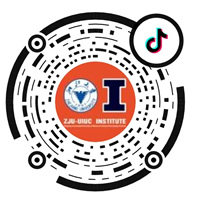Recently, Zhejiang University’s 2022 Undergraduate Student Research Training Program (SRTP) has been announced, and 48 ZJUI Undergraduate Student Research Training Programs (SRTP) were approved after strict evaluation by the expert team, including 6 national innovation projects, 6 provincial innovation projects, 19 university-level projects, 15 institute-level projects, and 2 scientific research and practice projects.
The topic selection of this SRTP reflects the characteristics of cross-disciplinary integration. Many groups focus on the frontier of technology, such as “Neural Network Colliding with Material Model,” “Correlated Noise Injection for Differentially Private Federated Learning” etc. There are also groups aiming at social problems, trying to break through traditional solutions by combining engineering methods, such as “Rehabilitation Type Assisted Walking Exoskeleton,” and “Wearable Sensors for Waist Posture and Disease Detection,” etc.
During the project approval process, students also took the initiative to contact professors from various interdisciplinary international research centers and other campuses of Zhejiang University according to their research interests. Under the guidance of experts in various fields, they set up a special research group to carry out projects such as “Perovskite light-emitting and energy electronic devices,” “Combinatorial Optimization Problem Solving Based on Ising Model,” and “Intelligent home design and experience platform design based on VR” and other topics.
Fitting in with societal needs
01
Wearable Sensors for Waist Posture and Disease Detection
Members: WU Qiyang, YANG Yihong, LIU Qiushi
Instructor: Assist. Prof. HU Huan
WU Qiyang, YANG Yihong, LIU Qiushi's team project " Wearable Sensors for Waist Posture and Disease Detection" focuses on solving the problem that there are few waist disease detection devices on the market for the general public. The team aims to create a sensor that can be used to detect posture and pressure on the waist, and to find ways to use the measured data for diagnosis and analysis and thus monitor the health of the waist in real time while achieving convenience and comfort.
02
Rehabilitation Type Assisted Walking Exoskeleton
Members: HE Zhuozheng, HU Kaihua, JIN Yiquan
Instructors: Assist. Prof. Liangjing Yang, Assoc. Prof. Wee liat Ong
JIN Yiquan, HE Zhuozheng, and HU Kaihua's group project "Rehabilitation Type Assisted Walking Exoskeleton" is originally designed to meet the walking needs of stroke patients or people who are unable to walk normally due to physical injuries. The development of the project can help these people get rid of the bondage of wheelchairs and hospital beds through the exoskeleton so that they can live a normal life.
03
Rehabilitation Glove with Grasping Function
——Application of gesture sensing system based on flexible conductive hydrogel
Members:CHANG Long, YUAN Chentai
Instructor:Assist. Prof. HU Huan
CHANG Long, YUAN Chentai's group project " Rehabilitation Glove with Grasping Function——Application of gesture sensing system based on flexible conductive hydrogel" aims at the problem that there is no rehabilitation glove on the market that can help patients with daily living problems, and will develop a new daily auxiliary gloves as rehabilitation gloves.
Focusing on cutting-edge fields
01
Heat Dissipation Performance Test System for Power Electronic Devices
Members:WANG Xuanqi; LI Zijin
Instructor:Assist. Prof. LI Chushan
Based on multilevel power electronic integration module radiator automated test system, WANG Xuanqi; LI Zijin's group project " Heat Dissipation Performance Test System for Power Electronic Devices" studied the equivalent element in the radiator system performance under different working conditions and provided valuable experimental data for the design and optimization of high-power density converter radiator system.
02
Semantic Communications for Unmanned Aerial Vehicles
Members:SUN Shanbin, LIU Xuecheng, ZHANG Jinhao
Instructor:Assist. Prof. ZHANG Meng
Based on deep learning, SUN Shanbin, LIU Xuecheng, ZHANG Jinhao's team project " Semantic Communications for Unmanned Aerial Vehicles", extracts semantic information by building a wireless network system, which can enable semantic communication between UAVs, making great breakthroughs in reducing communication loss and improving transmission rate and reliability.
03
Carbon Emission Flow in Modern Power Systems: Model, Measurement and Assessment
Member:WANG Ruizhe
Instructor:Prof. YANG Qiang
WANG Ruizhe's project "Carbon Emission Flow in Modern Power Systems: Model, Measurement and Assessment" optimizes the carbon emission flow model from the perspective of "electricity-carbon" coupling and builds a "source-grid-load" whole-chain, whole-cycle carbon emission metering method in new power systems, and finally establishes a model to evaluate the low-carbon-oriented power dispatch by using the above-mentioned model and measurement methods.
04
Design and Fabrication of Elastic Geodesic Grid Structures
Members:XU Tian, ZHAO Yiran
Instructor:Assist. Prof. Cristoforo Demartino
To actively respond to the country's "double carbon" policy, and based on the fact that China's bamboo resources are abundant, but wood resources are relatively scarce, XU Tian and ZHAO Yiran's project " Design and Fabrication of Elastic Geodesic Grid Structures" relies on the bamboo cantilever beam model and the bamboo two-stage stress bending model and comprehensively uses experimental exploration, mathematical modeling and other methods to measure the tensile elastic modulus E of bamboo structures and to test the creep speed of bamboo strips, so as to explore a feasible bamboo spatial structure to replace some traditional building materials (cement, steel, concrete), and make a preliminary exploration for a part of the structure of the new era.
SRTP aims at stimulating students' spirit of exploration, broadening their engineering vision, training students' ability to analyze and solve problems, especially cultivating students' ability of problem-oriented independent learning. SRTP provides undergraduate students with spare capacity the opportunity to directly participate in scientific research, and guides students to explore the frontier of science, experience research-based learning fun, and at the same time understand the dynamic development of social science and technology.







